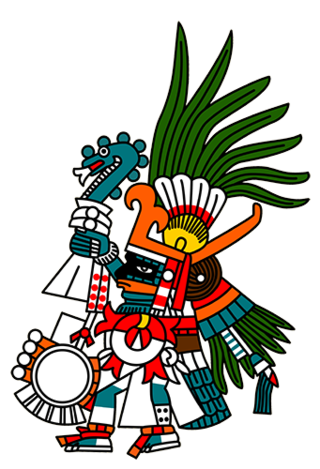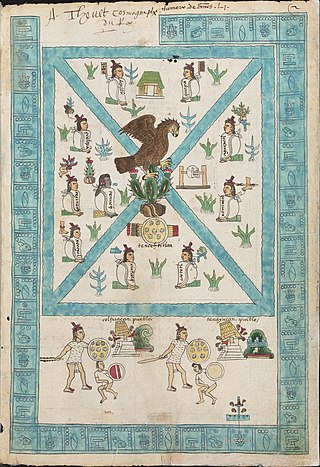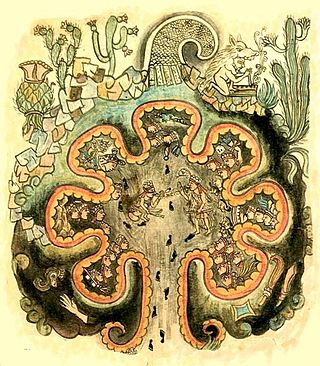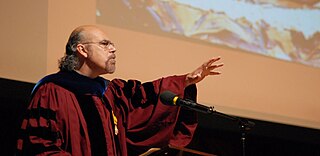Related Research Articles

The Aztecs were a Mesoamerican culture that flourished in central Mexico in the post-classic period from 1300 to 1521. The Aztec people included different ethnic groups of central Mexico, particularly those groups who spoke the Nahuatl language and who dominated large parts of Mesoamerica from the 14th to the 16th centuries. Aztec culture was organized into city-states (altepetl), some of which joined to form alliances, political confederations, or empires. The Aztec Empire was a confederation of three city-states established in 1427: Tenochtitlan, city-state of the Mexica or Tenochca, Texcoco, and Tlacopan, previously part of the Tepanec empire, whose dominant power was Azcapotzalco. Although, the term Aztecs is often narrowly restricted to the Mexica of Tenochtitlan, it is also broadly used to refer to Nahua polities or peoples of central Mexico in the prehispanic era, as well as the Spanish colonial era (1521–1821). The definitions of Aztec and Aztecs have long been the topic of scholarly discussion ever since German scientist Alexander von Humboldt established its common usage in the early 19th century.

Huitzilopochtli is the solar and war deity of sacrifice in Aztec religion. He was also the patron god of the Aztecs and their capital city, Tenochtitlan. He wielded Xiuhcoatl, the fire serpent, as a weapon, thus also associating Huitzilopochtli with fire.

In Aztec religion, Ītzpāpālōtl was a striking skeletal warrior and death goddess and queen of the Tzitzimimeh "star demons", who ruled over the paradise world of Tamoanchan, the paradise of victims of infant mortality and the place identified as where humans were created. She is the mother of Mixcoatl and is particularly associated with the moth Rothschildia orizaba from the family Saturniidae. Some of her associations are birds and fire. However, she primarily appears in the form of the Obsidian Butterfly.
Fernando de Alva Cortés Ixtlilxóchitl was a nobleman of partial Aztec noble descent in the Spanish Viceroyalty of New Spain, modern Mexico; he is known primarily for his works chronicling indigenous Aztec history.

The Great Pyramid of Cholula, also known as Tlachihualtepetl, is a complex located in Cholula, Puebla, Mexico. It is the largest archaeological site of a pyramid (temple) in the New World, as well as the largest pyramid by volume known to exist in the world today. The adobe brick pyramid stands 25 metres (82 ft) above the surrounding plain, which is significantly shorter than the Great Pyramid of Giza's height of 146.6 metres (481 ft), but much wider, measuring 300 by 315 metres in its final form, compared to the Great Pyramid's base dimensions of 230.3 by 230.3 metres. The pyramid is a temple that traditionally has been viewed as having been dedicated to the god Quetzalcoatl. The architectural style of the building was linked closely to that of Teotihuacan in the Valley of Mexico, although influence from the Gulf Coast is evident as well, especially from El Tajín.
Alfonso Caso y Andrade was an archaeologist who made important contributions to pre-Columbian studies in his native Mexico. Caso believed that the systematic study of ancient Mexican civilizations was an important way to understand Mexican cultural roots.

Aztec codices are Mesoamerican manuscripts made by the pre-Columbian Aztec, and their Nahuatl-speaking descendants during the colonial period in Mexico.

The altepetl was the local, ethnically-based political entity, usually translated into English as "city-state," of pre-Columbian Nahuatl-speaking societies in the Americas. The altepetl was constituted of smaller units known as calpolli and was typically led by a single dynastic ruler known as a tlatoani, although examples of shared rule between up to five rulers are known. Each altepetl had its own jurisdiction, origin story, and served as the center of Indigenous identity. Residents referred to themselves by the name of their altepetl rather than, for instance, as "Mexicas." "Altepetl" was a polyvalent term rooting the social and political order in the creative powers of a sacred mountain that contained the ancestors, seeds and life-giving forces of the community. The word is a combination of the Nahuatl words ātl and tepētl. A characteristic Nahua mode was to imagine the totality of the people of a region or of the world as a collection of altepetl units and to speak of them on those terms. The concept is comparable to Maya cah and Mixtec ñuu. Altepeme formed a vast complex network which predated and outlasted larger empires, such as the Aztec and Tarascan state.

The Spanish conquest of the Aztec Empire, also known as the Conquest of Mexico, the Spanish-Aztec War (1519–1521), or the Conquest of Tenochtitlan was one of the primary events in the Spanish colonization of the Americas. There are multiple 16th-century narratives of the events by Spanish conquistadors, their indigenous allies, and the defeated Aztecs. It was not solely a small contingent of Spaniards defeating the Aztec Empire but a coalition of Spanish invaders with tributaries to the Aztecs, and most especially the Aztecs' indigenous enemies and rivals. They combined forces to defeat the Mexica of Tenochtitlan over a two-year period. For the Spanish, Mexico was part of a project of Spanish colonization of the New World after 25 years of permanent Spanish settlement and further exploration in the Caribbean.

The traditions of indigenous Mesoamerican literature extend back to the oldest-attested forms of early writing in the Mesoamerican region, which date from around the mid-1st millennium BCE. Many of the pre-Columbian cultures of Mesoamerica are known to have been literate societies, who produced a number of Mesoamerican writing systems of varying degrees of complexity and completeness. Mesoamerican writing systems arose independently from other writing systems in the world, and their development represents one of the very few such origins in the history of writing.
The Aztec or Nahuatl script is a pre-Columbian writing system that combines ideographic writing with Nahuatl specific phonetic logograms and syllabic signs which was used in central Mexico by the Nahua people.

Cholula was an important city of pre-Columbian Mesoamerica, dating back to at least the 2nd century BCE, with settlement as a village going back at least some thousand years earlier. The site of Cholula is just west of the modern city of Puebla and served as a trading outpost. Its immense pyramid is the largest such structure in the Americas, and the largest pyramid structure by volume in the world.

The Historia Tolteca-Chichimeca is a 16th-century Nahuatl-language manuscript, dealing with the history of Cuauhtinchan. It is currently located in the Bibliothèque nationale in Paris.

Quetzalcoatl is a deity in Aztec culture and literature. Among the Aztecs, he was related to wind, Venus, Sun, merchants, arts, crafts, knowledge, and learning. He was also the patron god of the Aztec priesthood. He was one of several important gods in the Aztec pantheon, along with the gods Tlaloc, Tezcatlipoca and Huitzilopochtli. The two other gods represented by the planet Venus are Tlaloc and Xolotl.
Karl Anton Nowotny was an Austrian ethnographer, art historian and academic, specialising in the study of Mesoamerican cultures. He is most renowned for his analyses and reproductions of Mesoamerican codices, and his commentaries on their iconography and symbolisms.

Davíd Lee Carrasco is an American academic historian of religion, anthropologist, and Mesoamericanist scholar. As of 2001, he holds the inaugural appointment as Neil L. Rudenstine Professor of Latin America Studies at the Harvard Divinity School, in a joint appointment with the Faculty of Arts and Sciences' Department of Anthropology at Harvard University. Carrasco previously taught at the University of Colorado, Boulder and Princeton University and is known for his research and publications on Mesoamerican religion and history, his public speaking as well as wider contributions within Latin American studies and Latino/a studies. He has made statements about Latino contributions to US democracy in public dialogues with Cornel West, Toni Morrison, and Samuel P. Huntington. His work is known primarily for his writings on the ways human societies orient themselves with sacred places.
Codex Chimalpopoca or Códice Chimalpopoca is a postconquest cartographic Aztec codex which is officially listed as being in the collection of the Instituto Nacional de Antropología e Historia located in Mexico City under "Collección Antiguo no. 159". It is best known for its stories of the hero-god Quetzalcoatl. The current whereabouts of the codex are unknown. It appears to have been lost in the mid-twentieth century. Study of the codex is therefore necessarily provided only through copies and photographs. The codex consists of three parts, two of which are more important, one that regards the pre-Hispanic history of Central Mexico, the Anales de Cuauhtitlan and the other that regards the study of Aztec cosmology, the Leyenda de los Soles.
Mesoamerican cosmovision or cosmology is the collection of worldviews shared by the Indigenous pre-Columbian societies of Mesoamerica. The cosmovision of these societies was reflected in the ways in which they were organized, such as in their built environment and social hierarchies, as well as in their epistemologies and ontologies, including an understanding of their place within the cosmos or universe. Elements of Mesoamerican cosmovision are reflected in pre-Columbian textual sources, such as the Popol Vuh and the Cuauhtinchan maps, the archeological record, as well as in the contemporary beliefs, values, and practices of Indigenous people, such as the Maya, Nahua, and Purépecha, as well as their descendants. It has been argued that the Day of the Dead ceremony exists as a legacy of Mesoamerican cosmovision.
Omeyocan is the highest of thirteen heavens in Aztec mythology, the dwelling place of Ometeotl, the dual god comprising Ometecuhtli and Omecihuatl.

Mesoamerican codices are manuscripts that present traits of the Mesoamerican indigenous pictoric tradition, either in content, style, or in regards to their symbolic conventions. The unambiguous presence of Mesoamerican writing systems in some of these documents is also an important, but not defining, characteristic, for Mesoamerican codices can comprise pure pictorials, native cartographies with no traces of glyphs on them, or colonial alphabetic texts with indigenous illustrations. Perhaps the best-known examples among such documents are Aztec codices, Maya codices, and Mixtec codices, but other cultures such as the Tlaxcaltec, the Purépecha, the Otomi, the Zapotecs, and the Cuicatecs, are creators of equally relevant manuscripts. The destruction of Mesoamerican civilizations resulted in only about twenty known pre-Columbian codices surviving to modern times.
References
- Boone, E. H. (2000). Stories in red and black: pictorial histories of the Aztecs and Mixtecs. Texas: University of Texas Press.
- Botero, J. M. (2006). “Leader of serpents, the fall of the eagle”: The Map of Cuauhtinchan No. 2 as the Script of a Play . Master in Liberal Arts Thesis, Harvard University.
- Cosgrove, D. (2002). Introduction: Mapping Meaning. In D. Cosgrove (Ed.), Mappings (pp. 1–23). London: Reaktion Books Ltd.
- Harley, J. B. (1991). The New History of Cartography. Unesco Courier, 44, 10-15.
- Kirchhoff, P, Güemes, L, & Reyes, L. (1976). Historia Tolteca Chichimeca. Mexico: IMA-SEP-CISINAH.
- Reyes, L. (1977). Cuauhtinchan del siglo XII al XVI: Formación y desarrollo histórico de un señorio prehispánico. Wiesbaden: Franz Steiner Verlag GMBH.
- Yoneda, K. (2002a). Cultura y cosmovisión Chichimecas en el mapa de Cuauhtinchan No. 2. Unpublished doctoral dissertation, Vol. 1, Universidad Autonoma de Mexico, Mexico.
- Yoneda, K. (2002b). Los caminos de Chicomoztoc a Cholollan: Una migración Chichimeca (siglo XII). The Journal of Intercultural Studies, 29(2002), 90-116.
- Yoneda, K. (2005, May 19). Mapa de Cuauhtinchan #2 Cambridge Meeting [Glifos y mensajes del Mapa de Cuauhtinchan 2]. Harvard University, Cambridge.
- Wake, E. (2007). The Serpent Road: Colonial Iconic Script and the Historical Narrative of Mapa de Cuauhtinchan No. 2. In D. Carrasco (Ed.), The cave, the city, and the eagle's nest: An interpretative journey through the MC2. In press
